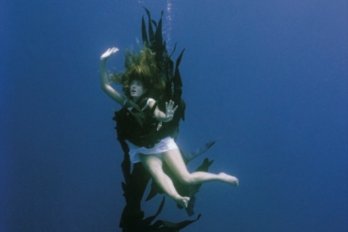One of the art world’s main events last year was the Havana Biennial. The festival, now in its eighth edition, is deliberately conceived as an alternative, “Third World” biennial, and last fall it featured powerful art from countries including Puerto Rico, Uruguay, South Africa, and, of course, Cuba. A local artist called Wilfredo Prieto had made a lovely outdoor installation in which he flew flags from around the world, official in every way except that their original bright colours had been replaced entirely with blacks and whites and greys. Another Cuban artist, Liset Castillo, showed aerial photographs of pristine highway projects—of on-ramps and cloverleafs and overpasses—except the turnpikes she’d photographed were really only miniatures modelled in sand.
Classic markers of national identity bleached of their identifying marks; dreams of a grand future sourced in a crumbling present: these were subtle works that would stand up in any exhibition of contemporary art, anywhere. And few would have seen them if it weren’t for a new development in the art world.
The past ten years or so have seen an explosion in the number of international art events. Buenos Aires, Cairo, Dakar, Havana, Istanbul, Johannesburg, Kwangju, São Paulo, Shanghai, Taipei, Tirana, Vilnius, Yokohama: that’s just a partial A-to-Z of the cities that have recently hosted major festivals of international contemporary art.
Closer to the art world’s traditional centres, prestigious events such as the Venice Biennale and Germany’s Documenta have begun to overflow with artists from countries that barely used to figure on the international art map. Artists from China, Malaysia, Brazil, Congo, Albania, and dozens of other developing countries now make regular appearances in the First World; any Western curator who wants to make a splash has to do some globe-trotting.
This all marks a crucial change. For years, a few countries in the North and West determined the kind of art that was shown in international exhibitions. Today’s art world is determined to do away with such navel-gazing Eurocentrism.
It’s an excellent ambition. It also has a crucial flaw: we may be opening our arms to artists from other countries, but we haven’t necessarily opened our eyes to truly foreign art. That may be because it can’t be done.
A work by the artist Alejandro Diaz, on view at the Havana Biennial, offers a hint of the problem at hand. Diaz had made clever work that applied U.S.-style merchandising to the Cuban experience: he manufactured vinyl beach bags with an “I LOVE CUBA” logo on them, and then passed them out at this Communist biennial. It was a powerful political statement about the interaction between the First and Third Worlds—just the kind of thing that the new, internationalized art scene is supposed to offer. It didn’t, however, need a Third-World artist as its maker: Diaz is, in fact, a New Yorker, and the piece is completely in line with mainstream art ideas born and fostered in Europe and the U.S. Indeed, in Havana last fall, it was impossible to tell which pieces were made by Third Worlders, and which were from the handful of artists invited from the First.
On the flip side, consider one of the most striking, original works on show at last year’s Venice Biennale, by the Malaysian artist Wong Hoy Cheong. Wong presented an installation in which the world economy was re-imagined with the Third World on top and the First World at its beck and call. He had constructed the living room of an imaginary Austrian “guest worker” who has migrated to do the dirty work in a wealthy, hegemonic Malaysia. Sitting in the Austro-Muslim living room—deer antlers mix with crescent moons; gemütlichkeit meets the Koran—we watch the worker’s television, and see a mockumentary about the plight of his fellow Western migrants, complete with commentary by a professor from an imaginary “Kuala Lumpur School of Occidental and European Studies.” Wong was riffing on a situation particular to his homeland and to his compatriots—but someone from the United States or Germany or Canada might equally well have made his piece.
That’s the catch. When Western curators find good work in far-flung places, it’s almost always close kin to the work we’ve all come to like at home. It’s art that answers to all the current Western notions of what makes good art good; it’s politically inspired installation art, or conceptual photography, or video. It may have some additional layers, addressing issues peculiar to its maker’s origins—a Cuban artist ponders globalization or fantasizes about development; a Malaysian artist touches on economic migration—but the terms in which it addresses them are essentially within the mainstream of current First World art.
That’s because what Western culturati count as “contemporary art” isn’t simply all and any art that’s made today, anywhere. Successful works of contemporary art are counters in a weird, esoteric, and very specific kind of Western game. The rules for playing it—the criteria for what counts as “significant” or “trivial,” even as “art” or “non-art”—depend on a peculiarly Western history of art and ideas, and on a peculiarly Western history of showing and selling. All the referees come from the West, or have been trained here: they have to be, to understand the game.
In a recent issue of Artforum, arguably the journal-of-record for American contemporary art, seven of the leading lights in international curating and artmaking were invited to discuss the new globalized art events. The panel included Catherine David, the high-powered French curator who organized the deeply political 1997 Documenta show, widely considered to have marked the coming of age of the new, globalized art event. It also featured the Nigerian-born, New York-based theorist Okwui Enwezor, another globe-trotting power-house on the international-exhibition circuit and David’s successor at the 2002 Documenta (which was even more political than her 1997 version), and Yinka Shonibare, a British artist of Nigerian descent whose art centres on issues of imperialism. Despite the apparent diversity of the participants, though, what was most noticeable about the round table was that the scholastic, distinctly Western debate barely extended beyond issues dear to the seven specialists involved. It didn’t even try to engage with people or issues beyond the art world, let alone outside the West. The new international exhibitions were declared to be “grand collectors and translators of subjectivities under the latest phase of globalization.” But it’s hard to know what someone with a genuinely foreign “subjectivity” would make of the insider interests and ideas at stake.
Of course, there is art that is genuinely different from what we see at home: printmaking traditions in India, textile traditions in South America, hair-braiding in Nigeria, even Modernist painting in rural Cuba. And, very occasionally, these truly “foreign” forms get a room or two at a global exhibition. (The Asia-Pacific Triennial, held in Australia, has taken some steps in that direction.) But, for the most part, truly indigenous forms are left out of the international mega-shows. When curators look for art in foreign cultures, it isn’t with a neutral, scientific eye for all the stuff that gets produced. They don’t usually want a knowledge of the current state of Indian or Bolivian or Nigerian visual culture; they want just those things that connect with the cutting edge at home.
On those rare occasions where some truly local heroes do squeeze into an international show, their art can look hopelessly out of place. At the Havana Biennial, a Senegalese artist named Ousmane Ndiaye Dago presented photos and a video from a project he called “Femme Terre.” It consisted of the artist, a fifty-something man, smearing mud and paint over much younger, suspiciously pert-breasted naked girls, while his pals snapped pictures of the moment. This art made most of the exhibition’s Western visitors cringe; many voted it the worst work in the show—and yet I bet that the artist, who is celebrated in his own country, would have been baffled by this reaction.
Occasionally, one of the global shows will feature a really successful work of genuinely “foreign” art, made far outside the standard contemporary-art circuit. When that happens, however, chances are the work is being used as an artistic ready-made—along the lines of Marcel Duchamp’s urinal or bottle rack, which started life as non-art objects, and only became Western high art by the artist’s fiat and with the acquiescence of curators and collectors.
Bodys Isek Kingelez, a self-taught artist from Congo, makes fantastic, room-sized cardboard and plastic models of Jetson-style cities of the future. They have now been shown in high-end exhibitions all around the globe. His work speaks to many of the Western art world’s current preoccupations. Echoing one stream in recent high-cred art, a Kingelez installation has a certain retro, Hanna-Barbera styling; echoing another, it explores the Utopian dreams of modernist architecture for their purely decorative potential—a lively contrast to the stodgy maquettes that the West is swimming in these days, for downtown Manhattan’s never-ending redevelopment, or for all the new museums and performance spaces that are springing up. Meshing with yet an-other current trend, a Kingelez rejects the hard-edged sobriety of 1960s abstraction and conceptualism, or the dour theorizing of 1980s work, and replaces them with a prankish celebration of a weird and wonderful mess.
And yet it’s not at all clear that any of this is what Kingelez, a hobbyist and former teacher, had in mind. There seems to be a genuinely Utopian dream behind Kingelez’s work, and an out-sider artist’s pure love of bricolage. But its original functions have little to do with recent trends in art. Kingelez’s constructions may be made to function as relevant contemporary installation art, but does that make him a contemporary installation artist? You have to wonder if any new body of work he made might be so in tune with contemporary Western art—given what little access he’s had to it. (Actually, he is now on his way to becoming another with-it artist, clued into the new contexts of his art, but that is only a result of more than a decade’s exposure to the Western contemporary art world.)
It is possible—just—to have a truly anthropological approach to artefacts brought in from foreign cultures. It is possible to understand an African mask, say, as a ritual object whose cultural job is almost completely different from the work done by modern Western art. But once you’ve done that, you’ve also pulled it right out of the ambit of Western curators, critics, and art lovers—who have no interest, one assumes, in engaging with foreign religious practices. Even to treat foreign objects as the subject for rationalist scholarly study, of course, is to situate them in a peculiarly Western system of thought. Is there that much difference between “using” foreign artefacts, Picasso-wise, as sources of our own kind of aesthetic satisfaction, and “using” them as sources for our own kind of intellectual pleasure? Either way, the objects aren’t being used in the way their makers had intended.
Actually, I’m not sure there’s anything wrong with the appropriation of foreign art. Ready-mades can be wonderful things; any culture can be invigorated when it steals images from far away and puts them to new use. When the Dani of New Guinea used empty sardine cans as exotic ornament, it was a good move; likewise when Mughal miniaturists and Japanese printmakers stole elements of Western perspective, and used them to their own, more purely graphic, ends. It’s what we’re up to when we understand Kingelez’s cardboard cities as installation art.
But it’s still important to recognize that our newly internationalized biennials are less about a generous openness to other artistic cultures than about an egocentric wish to energize our own. Modern Western art has a dedication to the new that other cultures don’t always share—it’s one of the hallmarks of our peculiar conception of art-making. The real reason contemporary curating has expanded its horizons is that there is a shortage of new work at home, and it seems likely we’ll find novel forms abroad. The harried visitors to the massive international biennials—critics, artists, high-end collectors, rival curators on scouting trips—don’t tend to pay too much attention to the complex curatorial agendas of the organizers. Instead, they inevitably switch into a kind of shopping mode, hoping to find good stuff to take away with them. You could even argue that this represents a new kind of colonialism: we in the West want a new supply of interesting goods to feed our appetite for aesthetic commodities, and we also wouldn’t mind a larger foreign audience, to provide demand for the art we make at home.
There can be a positive side to all this. For one thing, artists from abroad are finally getting to play in the Western art world’s game—a game that can be lots of fun and even makes some players rich. After all, it would hardly be fair to insist that foreign artists stick to some notion of an authentically “foreign” art; we can’t very well deny them the right to make the kinds of work for which we praise and pay our own artists. In Cuba, contemporary artists who’ve found success abroad are some of the richest members of their society—even when they work in installation or sound art.
And the idea of global art has spurred some artists to make work about the West’s determined search for the exotic, and about how artists themselves get caught up in it. Xu Bing, one of the most important art exports from China, is one such artist. (He now spends much of his time in New York. Like many other successful artists from the margins, the man and his art have both settled comfortably into the centre.) A recent body of work consists of an invented script called “Square Word Calligraphy,” in which English words are reworked to look like single Chinese characters. Thanks to Xu Bing, a Western audience can now have its exotic content and understand it, too.
Or there’s the Vancouver-based artist Brian Jungen, who in 2002 won the first $50,000 Sobey Art Award for best young Canadian artist. Jungen is half-native; his mother is from the Dunne-za Nation in the interior of British Columbia, a group once known as the Beaver Indians. But the artwork that first got him attention consisted of ritual masks in the red/white/black idiom of unrelated coastal tribes—masks that Jungen had sewn and glued together from disassembled Air Jordan running shoes. Jungen takes a stereotype of exotic identity—the kind a “native” artist is supposed to live up to—and lodges it squarely in mainstream commercial culture. Like Xu Bing’s Anglo-Chinese calligraphy, Jungen’s work as a cross-cultural cobbler depends on models of thinking and making peculiar to Western contemporary art—the world he has chosen to function in.
Each artist is playing the normal Western game. But their “foreign” roots may have given them a special handle on the fictions around which the global art world is built. And they have inspired both to make excellent, purely Western-style art about these structures. Global art gives us the same old same-old—only sometimes, better.






